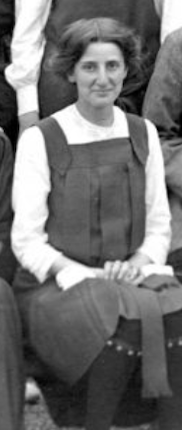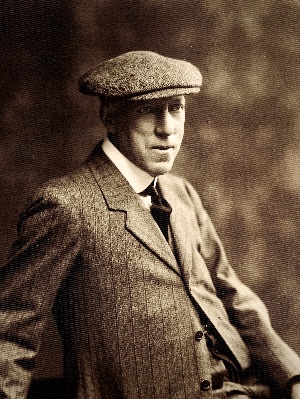Karpeles, Maud
Dancer
Collection date:
Area: London
Maud Karpeles OBE (1885-1976): Maud Karpeles met Sharp in May 1909 and, with her sister Helen, started an informal Folk Dance Club that produced a women’s folk dance team in 1910 and led to the formation of the English Folk Dance Society (EFDS) in Dec 1911. She made herself indispensable as a dance teacher, adjudicator and secretary for Sharp – especially when he was afflicted with neuritis in 1913 and could not physically write. She accompanied him on 3 of his 4 trips to USA, spending a total of 52 weeks travelling through the Appalachian Mountain states and noting down the lyrics (in shorthand) for most of the 1600+ songs they collected together. She carried a portable typewriter with her and her typed out texts can be found in the Folk Words section of Sharp’s archives at vwml.org (FW2301-3319) These journeys were often arduous with long hours of walking in extremes of weather – he was in his late 50’s, she in her early 30’s. It remains a truly remarkable achievement (see www.cecilsharpinappalachia).
After his death in 1924, Maud continued to work for the EFDS and made an important collection of folk songs in Newfoundland in 1929-30. With Pat Shaw she collected in 1952 an alternative tune for The Holly and the Ivy from Peter Jones in Herefordshire (see his profile). In the dance field she noted North-West morris dances and English country dances. She was awarded an OBE in 1961. Her work on the International Folk Music Council and other projects are described in the biography by Simona Pakenham (see reference below).
Maud Pauline Karpeles was born at 33 Lancaster Gate, Bayswater on 12/11/1885, third daughter of Joseph Nicolaus Karpeles, tea merchant and stockbroker, and his wife Emily. Joseph was born in Hamburg but became a naturalised British subject in 1881, while Emily was born in London, daughter of Henry Raphael, a foreign banker. They were both of Jewish ancestry but were non-practising. Maud's older sisters were Lucy (b1882), Florence (b1884). A younger sister Helen was born in 1888 and a brother Arthur was born in 1895. Soon after this, the family moved to 87 Westbourne Terrace, Paddington, where they stayed until Emily’s death in 1914.
Maud followed her older sisters to boarding school at Hamilton House, Tunbridge Wells and learned both the violin and piano there. She also studied German and in 1906 spent 6 months with her aunt and uncle in Berlin, taking private piano lessons at the Hochschule für Musik and going to concerts.
On return to England she worked as a volunteer for the Invalid Children’s Aid Association, which had a base within the Mansfield House University Settlement in the East End of London. For 3 or 4 days a week she would visit disabled children and their families at home, helping with hospital visits or developmental support. In addition a weekly Guild of Play meeting would bring local children together to do music and movement – her piano skills were useful. Her sister Helen helped her in this work. It was about this time that Maud joined the Fabian Society.
As described above, Maud and Helen attended the Stratford Shakespeare Festival in May 1909 and met Cecil Sharp at the folk competitions there. They attended his evening classes at the SW Polytechnic that autumn and not only enjoyed the dances themselves but took away ideas for their social work. The Mansfield House Settlement Annual Report for 1911 commended their Guild of Play work that year (p70) and the 1912 Report said: ‘The Folk Song and Dance Club has had a quietly successful year under Miss Karpeles with its annual display’ (p32) but later stated (p62) that ‘the Guild of Play…faces difficulties as (Miss Karpeles) is compelled by pressure of other work to give up the leadership at Xmas and we don’t yet see any signs of anyone to take her place’. This would be the time that Maud was starting to act as a secretary to Sharp.
Maud’s commitment to her social work over these 5 years (1907-12) is borne out by the fact that after she and her sister Helen had started their informal Folk Dance Club at their parents’ house in 1910, they decided to hold a fundraising concert for the Invalid Children’s Aid Association on 3 April 1911. The women’s team danced, Mattie Kay sang and Sharp lectured. It was held at the Portman’s Rooms in Baker St and raised £60 - a huge sum at the time (Westminster Gazette notice 29 March 1911). Also in 1911 Maud took some of her Guild of Play children up to Stratford to perform as well as some older dancers to Retford, Notts in July (Sharp called them her ‘Canning Town Contingent’ in letter to Maud 3 July MK/3/7).
Maud was diminutive in stature, much smaller than her younger sister Helen. See them dancing together in the kinora films (early home movie) 'Lumps of Plum Pudding' (film 3) https://youtube/bQEkXMCusuI. They were both good dancers and soon after they accompanied Sharp to watch the Bampton morris dancers on 16 May 1910 (Whit Monday), he wrote to Maud saying he was keen ‘to rope you and your sister into my staff of teachers’ (MK/3/1). They continued to try out the new dances that Sharp was recording (including the sword dances from Grenoside & Flamborough Aug/Dec 1910).
Maud joined the committee of the new English Folk Dance Society at its formation in Dec 1911 but did not initially take on a bigger role, perhaps because she still had commitments at the Mansfield House settlement. In 1912 and 1913 she began taking her own dance classes and was in close touch with Sharp, gradually taking on secretarial responsibilities. According to her autobiography (MK/7/185 p45) Maud travelled daily from her Paddington home out to Uxbridge during 1913 to act as Sharp’s secretary. Sharp had moved his family there in May 1911 because of his daughter Dorothea’s ill-health. Initially Maud took down letters in longhand but had quickly to learn typewriting and shorthand skills.
Maud’s mother had been ill for some time, staying in a nursing home in Devonshire Terrace, Marylebone (1911 census) and when she died in Feb 1914, Maud and sister Helen moved into a flat in Gloucester Rd. Maud was then involved in May 1914 in Granville Barker’s production of Shakespeare’s ‘A Midsummer’s Night Dream’ at the Savoy Theatre, wherein the usual Mendelssohn music in Act 4 was replaced by folk music and dancing arranged by Sharp. Maud trained the dancers. When war broke out in August 1914, Sharp was too old to contribute to the war effort and decided to take up Granville-Barker’s invitation to take the production to New York. Sharp sailed in December but Maud did not accompany him.
In early 1915 Sharp gave lectures and even invited Mattie Kay to sail across and take part but American audiences seemed more interested in folk dance than folk song. Several EFDS branches were formed (New York, Boston, Chicago and Pittsburgh) and these became the Country Dance and Song Society of America (www.cdss.org) that exists today. Sharp was pleased with the Shakespeare production - ‘I am quite certain I shall never do anything half so beautiful again’ (letter to Maud MK/3/61) - but audiences were not heavily subscribed and he returned home in April.
Maud sailed to USA in June 1915 to join Sharp on his second trip to America and to help him run a Summer School at Eliot, Maine (60 students). After meeting Mrs Olive Campbell from North Carolina who showed him songs she had collected in the Southern Appalachian Mountains, Sharp resolved to return to USA as soon as he could. In Feb 1916 he sailed again on his third trip and Maud followed in April. They began song collecting in North Carolina at the end of July (compare Sharp’s FT3168 to Maud’s FW2307 from singer Granny Banks of White Rock). Singers were interested to know the relationship between Maud and Cecil Sharp whereupon Sharp began introducing Maud as ‘his adopted daughter’ (p79 of Maud’s autobiography). They returned to England in Dec 1916, having collected nearly 400 songs. Sharp was at last able to start visiting his son Charles in Highgate Hospital – Charles, aged 20, had been badly wounded in the war.
Sharp and Maud Karpeles conducted 3 more field trips to the Appalachians in 1917-1918 and the full story of their expeditions has been well told in ‘Dear Companion’ EFDSS 2004 (Bradtke, Taylor & Yates including a short biography of Maud by Mike Yates). Maud was co-author with Sharp of Country Dance Book Part V, which contained the Running Set dance from Kentucky (Novello 1918).
After the war, Maud continued with her work with the EFDS, taking over as Hon Sec from her sister Helen in 1921. She had classes to teach and to staff – London classes had reached 3,000 attendances weekly by 1924. A system of examinations for dancing had been instituted - by 1924 over 3,800 certificates of merit had been awarded. The 23 provincial EFDS branches needed support and the Vacation Schools at Stratford (summer) and at the SW Polytechnic (Xmas) had to be organised. Easter Schools sprang up at York, Manchester and Aldeburgh.
When Sharp’s health deteriorated in October 1923, Maud made arrangements to accompany him to Montreux in Switzerland, where her older sister Lucy lived. He benefited from medical advice in his two months there but in June 1924 Sharp died in London. Maud would live and work for folk music for another 50 years.
Maud Karpeles never married. She died in London on 1/10/1976, aged 90, 6 months after her sister Helen’s death in Suffolk.
For Maud’s typed autobiographical notes type MK/7/185 into vwml search box
Simona Pakenham ‘Singing and Dancing Wherever She Goes’ EFDSS 2011
Also ‘Maud Karpeles’ by Michael Heaney in Oxford Dictionary of National Biography


